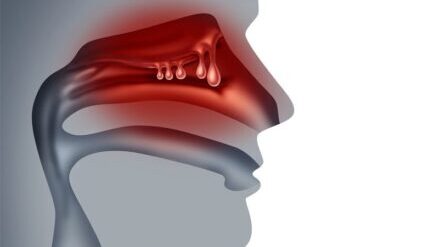
Nasal polyps are non-cancerous growths that form along the lining of the nasal passages or sinuses. Soft, painless, and often resembling small teardrops or grapes on a stem, these growths may not cause any noticeable symptoms when small. However, as they grow in size, they can lead to complications and disruptions in the natural functionality of the nasal passages.
Understanding Nasal Polyps
Nasal polyps are a result of chronic inflammation in the lining of the nose or sinuses, often associated with allergies, recurring infections, asthma, drug sensitivity, or certain immune disorders. Unlike some growths, nasal polyps are non-cancerous and don’t pose a threat as tumors, but they can significantly affect the quality of life by blocking normal airflow and sinus drainage.

Symptoms of Nasal Polyps
In their initial stages, nasal polyps might not exhibit any symptoms. However, as they grow, they can lead to:
- Nasal congestion, making it difficult to breathe.
- A runny nose with clear or colored mucus.
- Postnasal drip, where excess mucus runs down the back of the throat.
- Reduced sense of smell and taste.
- Facial pain or headache.
- Snoring or difficulty sleeping.
- Frequent nasal infections.
- Breathing difficulties, especially for those with asthma.
Causes and Risk Factors
While the exact cause of nasal polyps is not clear, several conditions and factors can increase the risk of their development:
- Chronic inflammation: Long-standing inflammation from conditions such as chronic sinusitis can lead to polyp formation.
- Asthma: Individuals with asthma seem to have a higher risk of developing nasal polyps.
- Allergies: Allergic reactions to airborne fungi can be linked to polyp development, as can allergic rhinitis.
- Drug sensitivity: Some individuals who are sensitive to aspirin or non-steroidal anti-inflammatory drugs (NSAIDs) may develop polyps.
- Recurring infections: Chronic infections can lead to prolonged inflammation and subsequently to polyps.
- Genetics: There seems to be a genetic predisposition, with some families having multiple members with nasal polyps.
Diagnosis and Treatment
A comprehensive examination, often involving a lighted instrument, helps in the initial identification of nasal polyps. Further diagnostic tools like CT scans can be used to determine the size and exact location of the polyps.
Treatment often depends on the size and impact of the polyps.
- Medication: Nasal corticosteroids are the primary treatment, reducing the size of the polyps and the associated inflammation. If corticosteroids are ineffective, other medications like antihistamines, antibiotics for concurrent infections, or even short courses of oral corticosteroids might be prescribed.
- Surgery: In cases where medications are ineffective or the polyps are excessively large, surgery may be recommended. Polypectomy is a common procedure where polyps are removed surgically. However, even after removal, polyps can recur, especially if the underlying cause, like allergies or chronic inflammation, isn’t addressed.
Complications and Long-Term Outlook
Nasal polyps can lead to complications, most notably by blocking normal airflow and sinus drainage. This blockage can result in chronic sinusitis, sleep disturbances, or secondary bacterial or fungal infections.
The long-term outlook for individuals with nasal polyps varies. Many experience relief with treatment, but recurrence is common, especially if triggers are not identified and managed.
